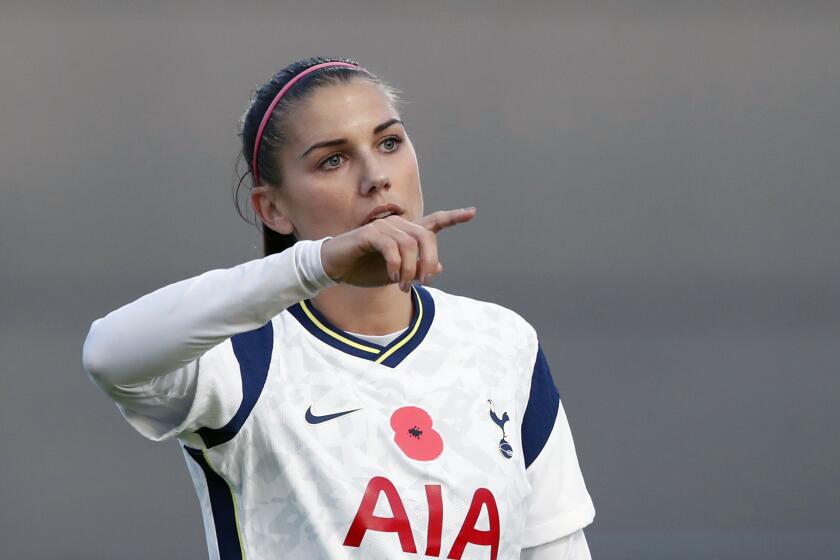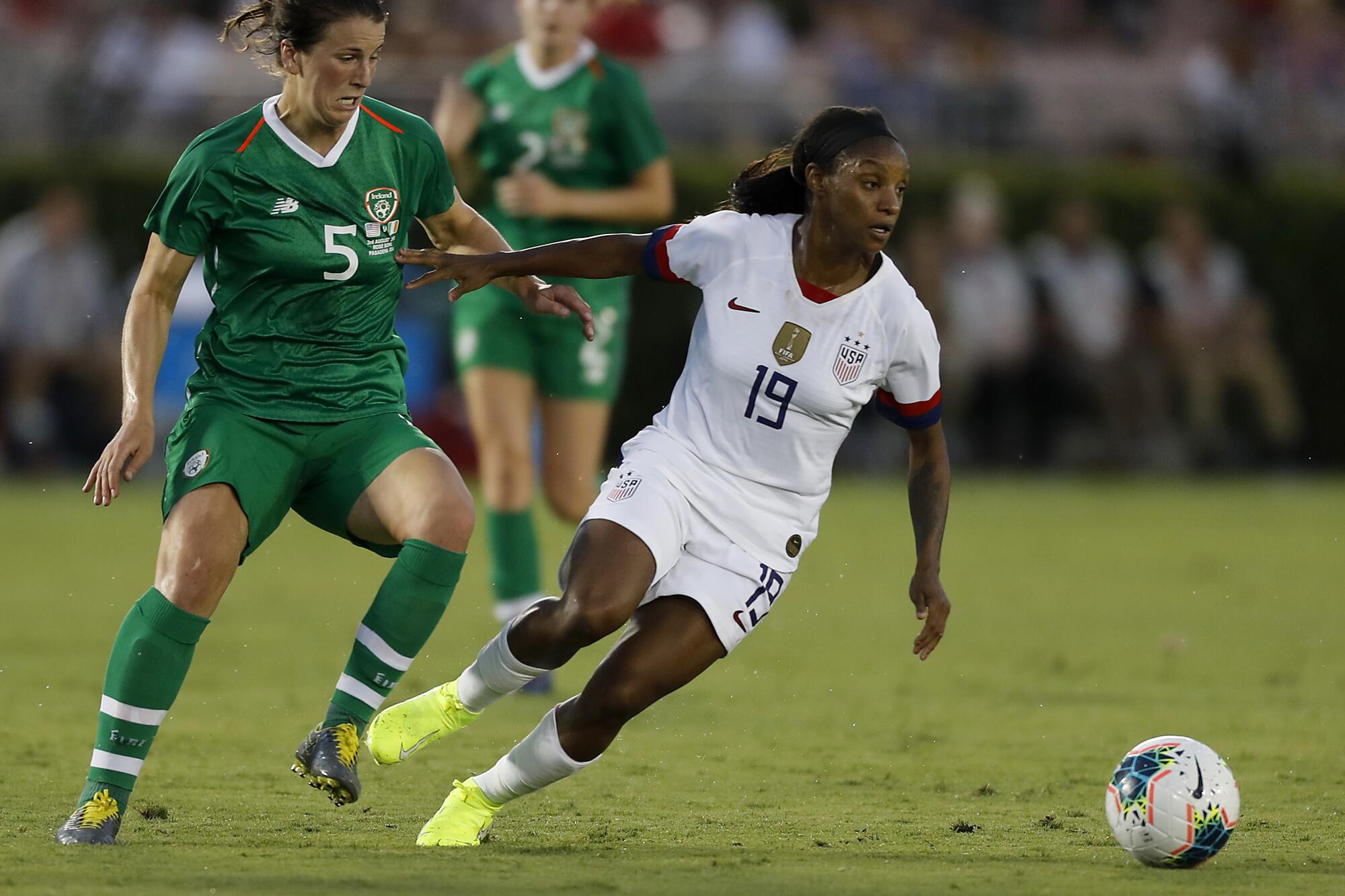
- Share via
Crystal Dunn has two dates circled on her calendar.
One is in mid-May, when she is scheduled to give birth to her first child, a boy. The other is in July 2023, when she hopes to play in her second Women’s World Cup.
Getting from one such milestone to the next was once considered difficult, if not dangerous for world-class athletes like Dunn. But now soccer moms have become commonplace around the U.S. national team.
Because the prime years of a soccer career are also the safest and most common years to give birth, women once had to choose whether they wanted to play soccer or start a family. Now, increasingly, they’re deciding they want to do both. If Dunn makes the roster in 2023, she will become the seventh woman since 2012 to play for the national team after giving birth and the 14th overall.
“You can’t be selfish or think about yourself. If there’s only so much room in your backpack or your suitcase, the priority goes to the kid. ... It’s definitely so much harder than I ever anticipated.”
— Alex Morgan, on juggling playing and motherhood
“I always wanted to be a mom alongside my playing career,” said Dunn, 29, a World Cup champion and two-time Olympian. “I think it was just about waiting for the right time. These last couple of years have been a lot physically, mentally, emotionally. Those were the years that really got me realizing that I want to be a mom.”
That realization hit Alex Morgan just after the last World Cup, where she scored a tournament-high six goals and had three assists in winning her second straight championship. At 30, she was in the best form of her career and acknowledged she had “that fear of not being able to get back to where I was 100%.”
The reality has been just the opposite. Her daughter, Charlie, who turns 2 in May, has given Morgan’s career a boost.
“The best part of the game is getting to see Charlie after,” she said. “As much as I love playing soccer, and doing that every single day, I now play for more than myself. I don’t know if I would say I’m a different player. I just think that I’m more evolved.”
She evolved when it comes to packing as well.
“You can’t be selfish or think about yourself. If there’s only so much room in your backpack or your suitcase, the priority goes to the kid,” she said. “The thing that I try to remind myself is don’t forget your cleats because that’s literally the only thing I actually need for myself.
“It’s definitely so much harder than I ever anticipated.”
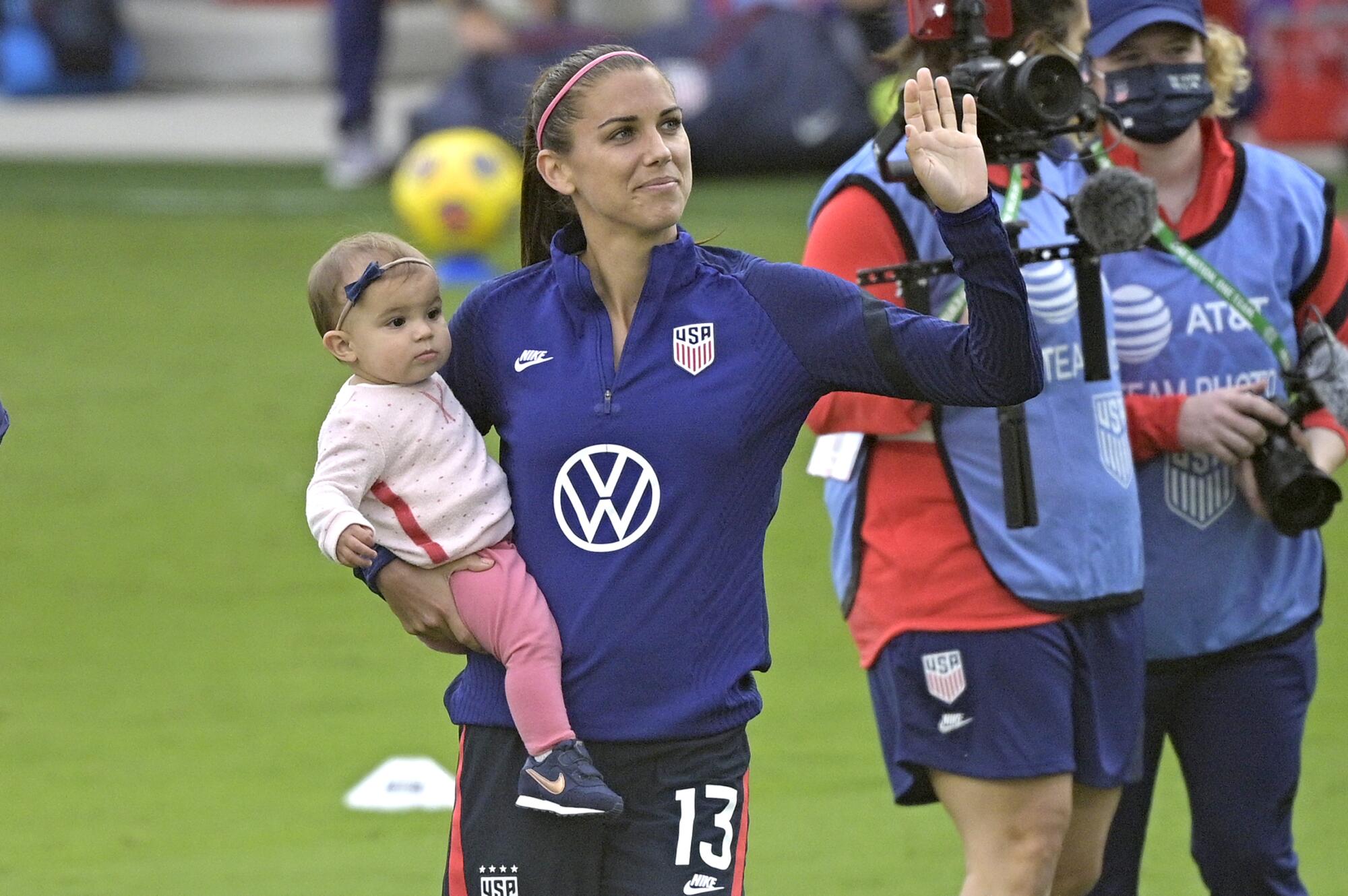
It used to be even harder.
Both Dunn and Morgan have access to U.S. Soccer benefits, among them maternity leave and paid nanny care — including airfare, hotel rooms, meals and a daily stipend for babysitters — at national team camps and on road trips.
None of that was available when Joy Fawcett became the first U.S. Soccer mom in 1994. But if at first she had little help, she found little opposition from coach Anson Dorrance.
“I’m going to have kids and I’m going to bring them with me. Is that OK with you?” Fawcett remembers asking the coach. “He said, ‘Yeah, that’s fine.’”
Crystal Dunn watched the last Women’s World Cup on television. Sometimes through tears.
“That’s all I wanted,” Fawcett said. “Just to be able to bring them along.”
Not that Dorrance had much choice. Fawcett made her international debut in the 15th game in national team history and helped the U.S. win the first Women’s World Cup in 1991. The program barely existed before she showed up and wouldn’t be nearly as good if she went away. So to keep her and others who were thinking of starting families, in the run-up to the 1996 Olympics, U.S. Soccer agreed to provide free child care for its women players.
Before the next Olympics, two more players became mothers.
“Well, you can’t do it by yourself,” said Kate Markgraf, the general manager for the women’s team and a former national team defender who played more than 200 games for the U.S. “You need to have trusted caregivers. We can’t do this as moms unless you have people that you trust.”
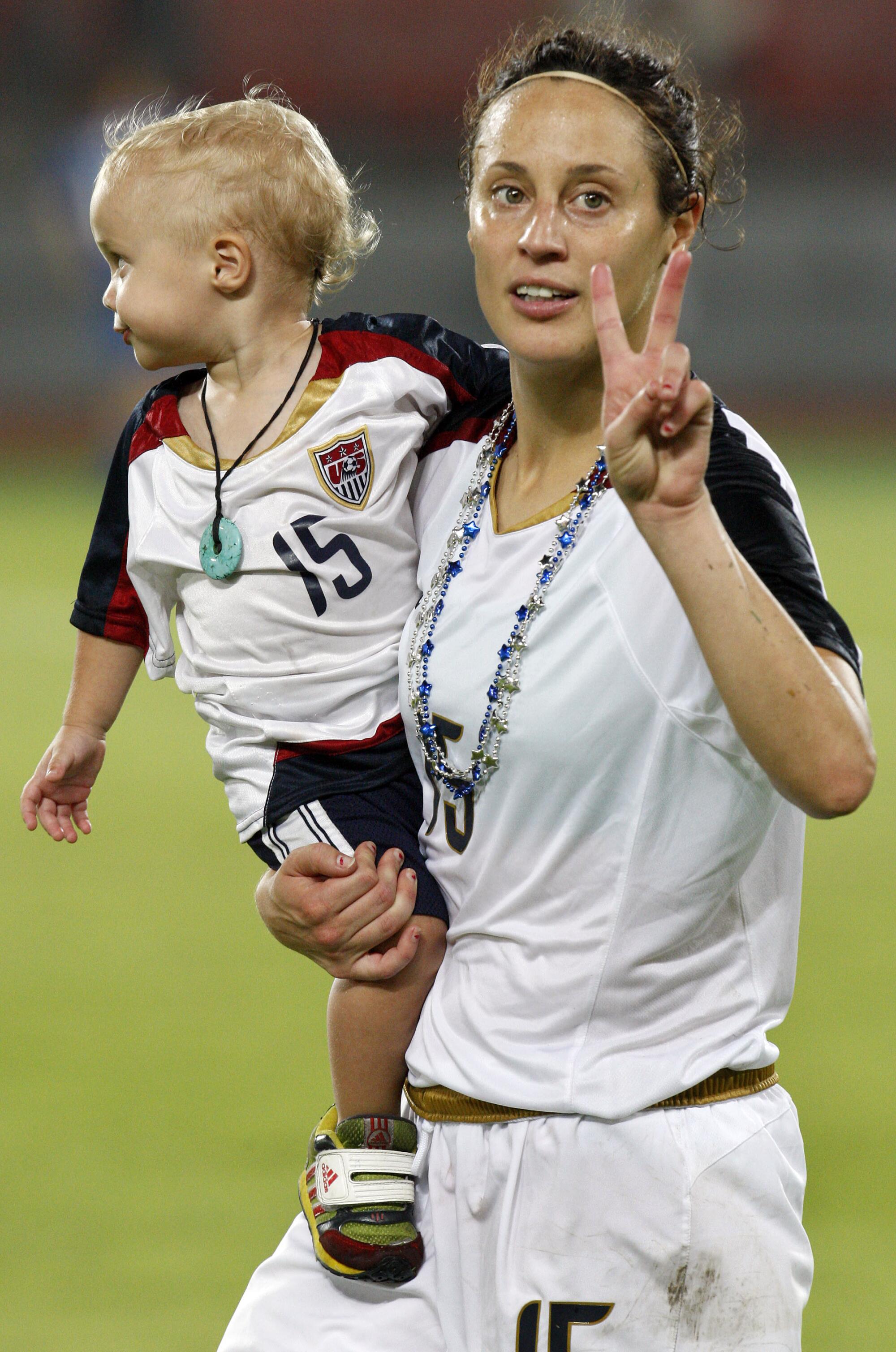
As general manager, Markgraf, who gave birth to three children during her playing days, pushed U.S. Soccer to extend its pregnancy protection and maternity leave policies and to extend them to players who adopt a child. Players under contract with the federation now receive 75% of their salary while on leave and paid child care while with the team when they return.
But if that helps ease the financial burdens of starting a family, it does little to address some of the physical and emotional questions that arise from pausing a soccer career to give birth.
“Sacrificing a full year off of [our] career — and our careers are not very long — is a big decision that you shouldn’t take lightly,” Dunn said.
“It did cross my mind like, ‘Oh, man, I’m going to be out for a while. Am I going to be the same player when I come back? Am I going to be able to withstand the demands of the game again?’
“Throughout my career, I’ve been so adaptable and so versatile, I’m not really fearful of that. I just take it day by day and I don’t put any extra pressure on myself.”
Dunn, whose husband, Pierre Soubrier, is a trainer for her club team in Portland, has tried to stay as close as possible to her old routine, working out four times a week despite carrying more than 20 extra pounds. She avoids any activities that involve contact, but warms up with the team and does passing and tactical drills — all which have been made more difficult by the fact she no longer can see her feet.

“It never crossed my mind to be like, ‘I’m pregnant. Now I have to stop,’” she said. “I spoke to my doctors and they were all like, ‘Yeah, you’ve been an elite athlete before you were pregnant. There’s no reason why you can’t continue training.’ Passing the soccer ball, that is the least of their worries during my pregnancy.”
Morgan, under the supervision of personal trainer Dave Copeland-Smith, also trained through her pregnancy, taking a six-mile bike ride the day before giving birth. Despite that, coming back was more difficult than she anticipated.
“Your body is literally changing for nine months, and you can’t just expect it to go back to normal,” she said. “On top of that you’re dealing with a completely new life and raising a newborn.”
Morgan needed two months before she felt comfortable jogging and kicking a ball around, then returned to the field with English club Tottenham in November 2020, six months after giving birth and 15 months after her last game with the national team.

Fawcett, meanwhile, was playing for the San Diego Spirit six weeks after giving birth to her third child, whom she breast-fed during halftime of games.
“Exercise is a good thing during pregnancy as long as it’s a normal pregnancy,” said Dr. Aurelia Nattiv, a professor of family and sports medicine at UCLA and a former physician and consultant for multiple U.S. national teams. “For elite and professional athletes, it’s not a time to reach a [personal record]. But certainly to continue exercising during pregnancy, especially if they’ve been exercising at a high level before pregnancy, is safe.”
While health concerns, for both the baby and mother, are the primary worry, soccer moms also worry about the impact childbirth will have on their playing careers. It’s a sacrifice male players don’t have to consider when starting a family.
Morgan’s husband, Servando Carrasco, a former Galaxy midfielder, played 13 games for the Fort Lauderdale team in the third-tier USL League One while Morgan was recovering from giving birth.
“There’s obviously so much to take into account. As a female athlete we have to time our pregnancies. And obviously it always doesn’t end the way you want it to,” said Christie Pearce (formerly Rampone), who gave birth to both her daughters between major international tournaments.
“There’s no guarantee that you’ll be able to get back to the player you used to be. There’s no guarantee that you’ll be able to earn that spot back.”
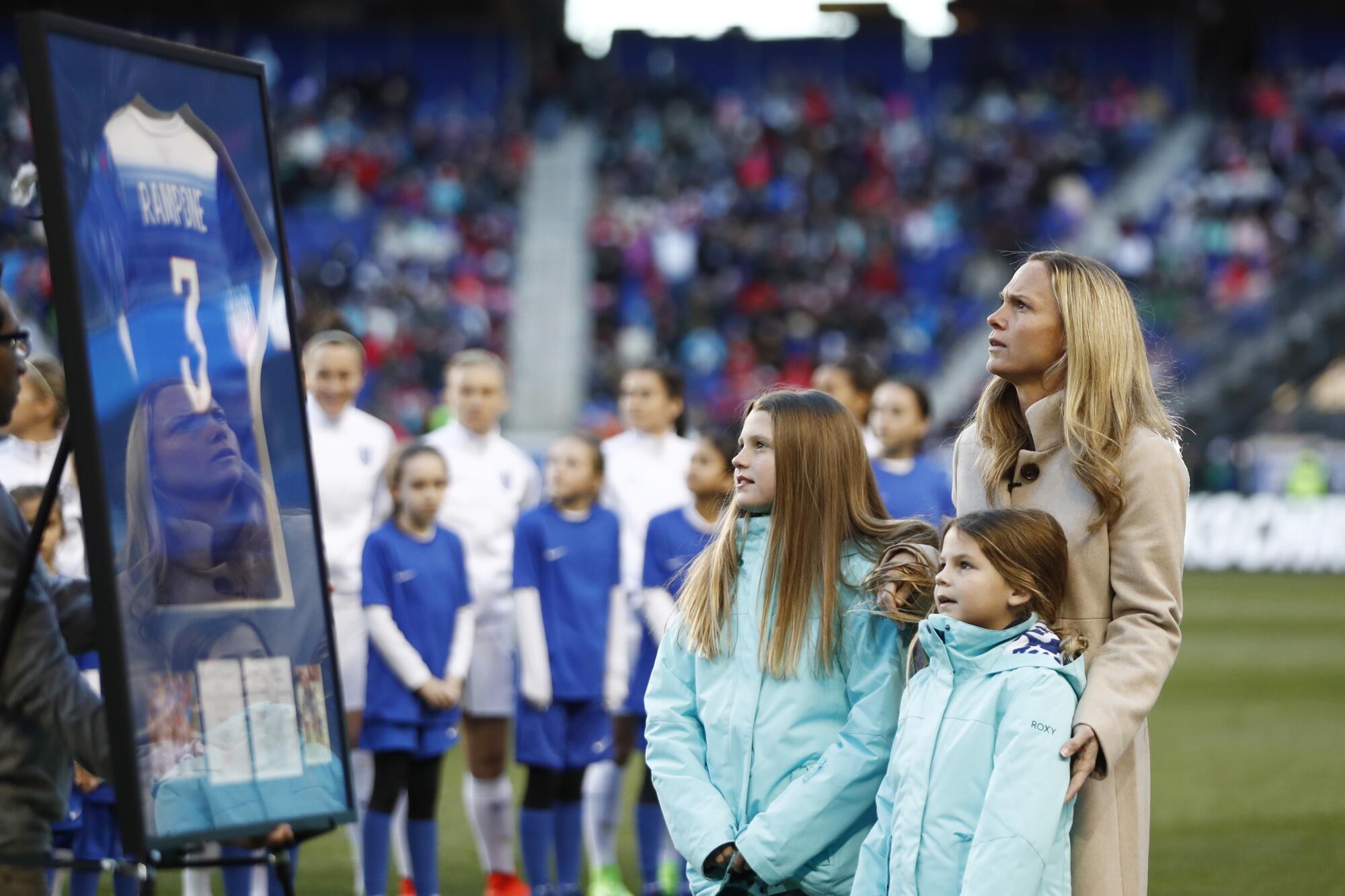
Markgraf acknowledged she wasn’t as dominant a player after giving birth to her first child in at 29. But the experience brought other things to her game and a year later she started five times in the 2007 World Cup.
“I wanted to have children while I was still playing,” she said. “I knew it would take a long time to come back because your body is different. [But] I always wanted to be able to have my children up in the stands wearing my jersey, watching me as a mom so they knew they could do difficult things.”
“You gain a perspective when you have kids; that that [poor] pass, it’s OK,” she added. “Because you come home and there’s a kid that’s so excited to see you.”
Fawcett agreed. After the U.S. lost to Norway in overtime in the 2000 Olympic final, the players groused about their silver medals — until Fawcett’s 6-year-old daughter Katey got a look.
“It’s the most beautiful thing I’ve ever seen!” the girl said.
Fawcett soon convinced her teammates her daughter was right, changing the mood in the locker room instantly.
“I was like, ‘What’s there to be sad about?’” she said.
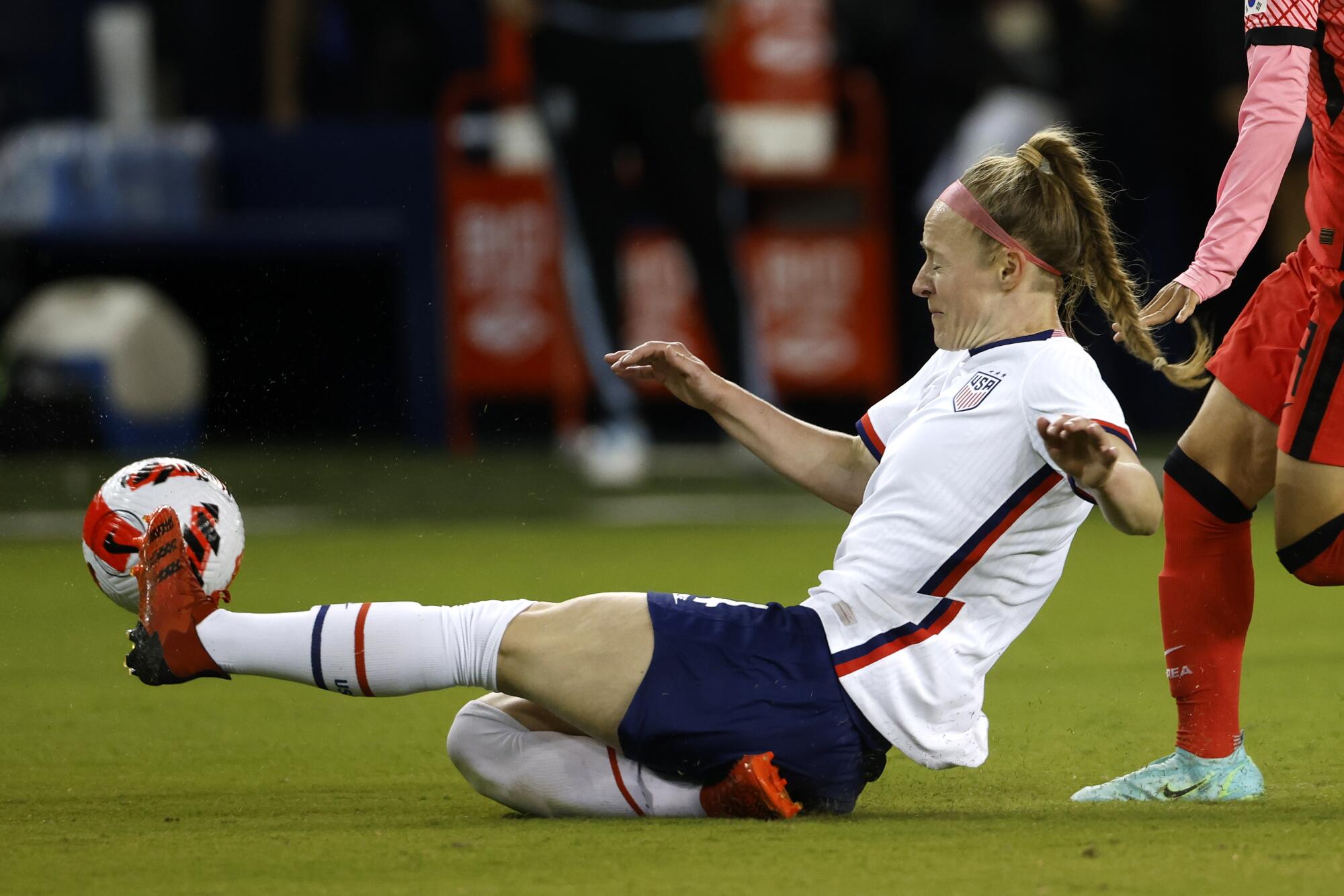
Becky Sauerbrunn, who replaced Markgraf both at center back and as a team captain, has taken a different approach to her family planning. She’ll be 37 in June, so rather than pausing or ending her career to give birth with the next World Cup 16 months away, Sauerbrunn had six embryos extracted and frozen late last year.
“It was almost to me unfair that I was having to basically contemplate the end of my career just to have a family,” said Sauerbrunn, who has played in 202 games for the national team, one more than Markgraf. “Soccer is my calling and my passion. Do I potentially have to end it early to kind of start the next chapter?
“The next chapter could be glorious. And I could find that being a mother is also my calling. But I really just wanted to see out a few more years of this first chapter.”
There has long been a stigma attached to extracting and freezing eggs, and that has intimidated some women. The WNBA, however, is encouraging the process by reimbursing players who undergo the procedure, which would allow them to continue their playing career while preparing for motherhood.
“It seems like there’s some sort of turning point happening, where more athletes are willing to talk about fertility problems,” Sauerbrunn said. “Why not use science to our advantage to have a family if that’s what you really want?”
U.S. soccer star Alex Morgan is preparing for the SheBelieves Cup, after a year in which she contracted COVID-19 and also had her first child.
Dunn really wants a family. But like Morgan and Sauerbrunn, she wants to play in the next World Cup too.
According to the circles on her calendar, she should be able to do both.
“These last couple of years, I was able to lean into more things off the field that really inspired me to be just not a great soccer player but a great human being,” Dunn said. “And I was like, you know, I think I am ready to start a family.
“It’s given me such a new motivation to come back and the best person and the best player I can possibly be.”
More to Read
Go beyond the scoreboard
Get the latest on L.A.'s teams in the daily Sports Report newsletter.
You may occasionally receive promotional content from the Los Angeles Times.


